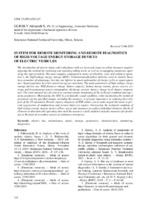System for remote monitoring and remote diagnostics of high-voltage energy storage devices of electric vehicles
Bibliographic entry
Gursky, A. S. System for remote monitoring and remote diagnostics of high-voltage energy storage devices of electric vehicles / A. S. Gursky // Транспорт и транспортные системы: конструирование, эксплуатация, технологии : сборник научных статей / Белорусский национальный технический университет ; редкол.: С. В. Харитончик (гл. ред.) [и др.]. – Минск : БНТУ, 2023. – Вып. 5. – С. 116-117.
Abstract
The introduction of electric buses and trolleybuses with an increased range as urban transport requires adjusting the methods for servicing and repairing rolling stock, as well as re-equipping enterprises operating this type of vehicle. The most complex component in terms of reliability, cost, and technical operation is the high-voltage energy storage (HSE). Lithium-iron-phosphate batteries used in electric buses have a number of advantages, but they are inferior in speed and number of charge cycles to supercapacitors. Supercapacitors have less stored energy per unit mass. The main parameters of high-voltage energy storage devices are: HSE (battery) voltage, battery capacity, battery energy reserve, power reserve, average and instantaneous power consumption, discharge current, battery charge level, battery temperature. The most rational way of control is constant remote monitoring of the technical condition and operation parameters. Maintaining the HSE in a technically sound condition, while maintaining the technical parameters in the specified ranges, including the resource, is of great importance in reducing the costly part of the EV operation. Remote express diagnosis of HSE allows you to make urgent decisions to prevent aggravation of malfunctions and prevent high-cost repairs. Forecasting the technical condition of high-voltage energy storage devices allows you to take measures to replace individual elements, blocks of elements or determine the operating time until the resource is fully depleted and take measures for further use in the form of secondary sources at stationary enterprises.

